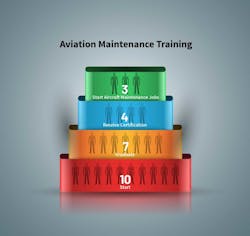Another Look at the Aviation Maintenance Personnel Shortage and the Solutions
Everyone is talking about the current and growing shortage of aviation maintenance personnel. Johnson summarizes results from a recent international training conference and combines his perspective regarding ways to address the human resource issues threating the industry.
Meeting of the Experts
Perhaps the best way to understand how the industry must address personnel shortages is to bring together the parties that are hiring new mechanics and the training organizations that are preparing newly credentialed and qualified personnel. The World Aviation Training Summit, one of a series of training conferences held annually (www.Halldale.com), assembles not only training companies but also the airlines and MROs that hire new mechanics. Those employers, because of the state of work readiness of new graduates, also become trainers. This article summarizes a small portion of proceedings of the maintenance training sessions.
A Real Problem?
Turn on the nightly news, read the paper, peruse the magazines, or blogs. The shortage of qualified aircraft mechanics is real. Industry experts discussed the issue at a recent summit. Mark Lopez, director - technical operations of Airlines for America, quoted a 2018 Oliver Wyman report and the ATEC Pipeline Report (12-2017) to emphasize that the U.S. demand for AMTs is heading up while the supply is slipping down. They predict a U.S. shortage of 15,000 certified AMTs by 2027, unless there is a big change in the supply. The worldwide shortages are proportionately greater. Crystal Maguire, executive director of Aviation Technician Educational Council (ATEC) and author of the ATEC Pipeline Report, amplified those numbers. Maguire estimated that U.S. AMT schools currently have the capacity to double the output of U.S. certificated aviation maintenance technicians, but that is not happening.
Why the Shortage of AMTs? Why Are Schools Below Capacity?
There are many reasons that school seats are going unfilled while the mechanic shortage grows. Lopez, Maguire, and Mac McDaniel, director of the Aviation College for the State of Alabama Community Colleges, often citing the Oliver Wyman report, discussed many. First, the current median age of aviation maintenance workers is 51 years, with 27 percent over 64 years old. That is nearly a decade older than the broader U.S. workforce. Many mechanics are currently retirement eligible. The growing size of the aircraft fleet and the changing technology of new aircraft exacerbates the challenge. The world fleet size will increase by 40 percent over the next 10 years. That means the old aircraft are still around while many new technology aircraft join the fleet.
Aviation jobs, including the piloting job, no longer lure today’s generation into aviation careers as they once did. Younger workers recognize that aviation jobs require extensive shift work, time away from home, without the pay and benefits that match the personal and family sacrifices. Service jobs in the computer, automotive, and other industries seem to be more attractive than aviation maintenance opportunities. Secondary school graduates head off to college, even though the percentage of unemployed new graduates is at an all-time high.
It takes, at least, two years to obtain certification as an FAA aircraft mechanic. The training and apprentice time in Europe nearly doubles that! That is a long duration of expensive tuition requiring extensive presence in the classroom and laboratories. The time constraint makes it very difficult to hold a job while in training. The estimated completion rate from AMT programs is about 70 percent, 60 percent of program graduates take the FAA certification exam, and 20 percent of graduates take jobs outside of aviation. Airline employers say that most newly certified AMTs are not qualified for unsupervised work. The current situation is grim.
Another challenge to attracting potential U.S. AMTs is the expressed and perceived status of the certified aviation maintenance technician. The U.S. Department of Labor places certified AMTs in the major group “Installation, Maintenance, and Repair Occupations.” Typically, workers in this category do not have the extensive initial and continuing training and exam requirements of the FAA Certified A&P. It follows that secondary school counselors are less likely to suggest this line of work. Further, such labor classification hardly helps raise the salary to match the credentials and impending occupational shortages of AMT personnel. Associated with perception is the title “mechanic or technician.” In most of the world, the term “engineer” applies to one who maintains aircraft. While status is an unlikely major cause of the AMT shortage, it is one of many contributing factors.
The Schools and the AMT Curriculum
For a long time many U.S. AMT schools, regulated by CFR 65 Part 147, have used the outdated FAA curricular requirements as a good reason to have outdated, antiquated equipment. Traditionally, it has been more affordable to use old reciprocating engines; traditional airframe construction and repair equipment; and low technology instructional methods/equipment to meet the “FAA requirements.” Further, to remain commercially competitive, schools strive to complete the training in the required minimum time of 1,900 hours, about two years within a standard academic calendar. That translated into “old-fashioned” vocational education.
Round engines have evolved to turbine wheels, fabric has become composite material, and avionics have become computers. Instructional methods have evolved to extensive use of computer-based instruction, advanced simulations, and distance learning. Schools know that they must become increasingly selective on the qualifications of new instructors and the recurrent training of current staff. With qualifications beyond an A&P certificate, instructors must be current not only in aviation technology but also in academic technology.
Schools are focusing on developing competence and relevant occupational skills rather than counting hours and checking instructional boxes. Many schools know that it takes more than 1,900 hours to qualify one to maintain modern aircraft. Schools have increased their partnerships with industry. A new generation of proprietary schools are setting higher standards, which are driving the publicly funded schools to keep up.
AMT Training Providers Are Organizing
Traditionally, Part 147 schools have suffered from limited collective organization. That translates to changes to a curriculum becoming a contest between a single institution and the FAA, hardly an even match.
That situation has changed. A number of commercial organizations opened Part 147 programs at multiple sites and are exerting their influence to question the local FAA school inspectors and FAA headquarters. Industry associations, like ATEC and the Aeronautical Repair Station Association (ARSA), have become influential in helping government to evolve Part 147. That helps the small as well as the larger schools. Change is in the air. Mac McDaniel, from Alabama Aviation Colleges, commented that we must move forward, “There is no longer time to wait!”
Positive school lobbying and congressional attention to the impending worker shortage is influencing the FAA to move faster on curricular reform. In March, the U.S. Senate introduced Senate Bill 2506 “To establish an aviation maintenance workforce development pilot program.” That proposed bill offers local and state grants for equipment, scholarships, apprenticeships, career outreach, targeted opportunities for economically disadvantaged, and ways to transition military personnel. House Bill, H.R. 5701, introduced in May, is a complement to the Senate version.
A potentially significant Senate Bill 2792, introduced in May is titled, “A bill to modernize training programs at aviation maintenance technician schools.” That bill gives the FAA 180 days to issue final regulations to modernize Part 147. That is accelerated rulemaking! This congressional action is certainly a step to alleviate the potential personnel shortage by promoting long-overdue change to the maintenance training regulations. With good industry participation and cooperation between the FAA groups that write the tests and those that establish the curriculum, a fast rule change is possible. Such a new rule would likely ensure that school curricula content could be more easily adapted to commercial requirements than it is currently.
Change in the Air?
The FAA understands the challenge and is cooperating with all parties to adjust Part 147 to ensure an adequate number of safe and qualified personnel. An example of rulemaking progress, regarding the use of distance learning for aviation maintenance, is the introduction of a new hybrid-training program at Spartan School of Aeronautics and Technology. At the WATS Conference, Spartan president/CEO, Dr. Dan Peterson, described the Spartan hybrid approach to certify aviation maintenance technicians. That new FAA approved program uses 13 months of online distance education followed by seven months of residence instruction at the Tulsa, OK, campus. This is a radical change in delivery method.
Even with curricular changes, the certification testing system also needs review. There are a limited number of designated mechanic examiners (DME) to serve school graduates. The total exam time, for the General, Airframe, and Powerplant Certificate could last for two days. In most cases, students pay a fee of nearly $2,000 for the post-program certification exams and associated logistic expenses. Some suggest that these fees should be included in the school fee. There must be a reasonable way to ensure reliability and validity of the certification exam. AMT competence is much more than passing every class in an AMT curriculum. The certification exam must remain as a final assimilation of technical knowledge, hands-on skill, and diagnostic decision making to ensure that an applicant is able to enter the next phase in an aviation maintenance career.
Positive Steps to Address the Challenge
For Schools:
• Emphasize the worker shortage
• Modernize aircraft and training technology
• Reinforce partnerships with industry
• Increase attendance options for students
• Propose and test new alternative curricula and competence-based solutions
• Address certification testing
• Ensure recurrent training for instructors
• Increase diversity of student population
• Focus on competence to pass certification rather than on program completion
• Match graduate skill and competence to local aviation employment opportunity
For Industry:
• Ensure attractive compensation and benefits for certified AMTs
• Actively recruit all newly certified personnel (no escape to other industries)
• Improve marketing of AMT profession at all levels of schools
• Assist with certification testing challenges
• Collaborate with schools
• Help schools with equipment
• Increase apprenticeship opportunities
• Offer tours of maintenance facilities
For Government:
• Recognize the urgency
• Capitalize on risk-based decision making
• Consider all reasonable proposed new curricular modifications
• Help schools with certification testing
• Do not wait for congressional mandate
• Stay the new current course for change
About the Author

Dr. Bill Johnson
Chief Scientific and Technical Advisor Human Factors in Aviation Maintenance, FAA
““Dr. Bill” Johnson is a familiar name and face to many industry and government aviation audiences. Johnson has been an aviator for over 50 years. He is a pilot, mechanic, scientist/engineer, college professor, and senior executive during his career. That includes 16+ years as the FAA Chief Scientific and Technical Advisor for Human Factors.
Dr. Bill has delivered more than 400 Human Factors speeches and classes in over 50 countries. He has 500 + publications, videos, and other media that serve as the basis for human factors training throughout the world.
Recent significant awards include: The FAA “Charles E. Taylor Master Mechanic” (2020); The Flight Safety Foundation - Airbus “Human Factors in Aviation Safety Award” (2018), and the International Federation of Airworthiness “Sir Francis Whittle Award” (2017).
Starting in 2021 Johnson formed Drbillj.com LLC. In this new venture he continues to bring decades of human factors experience to aviators, worldwide.
